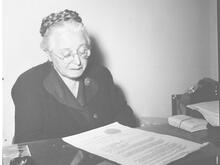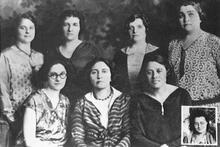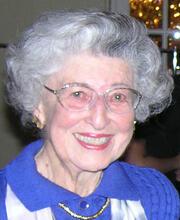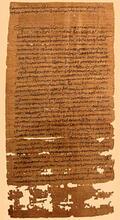Librarians in the United States
Jewish women had trouble finding positions in libraries until the 1940s and 1950s. Even in Jewish libraries, roles were primarily designated to men. In the late 1940s, the Jewish Book Council began to encourage the development of Jewish libraries in synagogues, centers, and other institutions throughout the United States as a way of increasing interest in Jewish books and thus Jewish culture. Beginning in the 1950s, individual women librarians began to lay the foundation for cooperation in librarianship in synagogue, school, and center environments, as well as in specialized research libraries. In 1962 the Jewish Library Association was founded. Jewish women have frequently published impactful pedagogical work on librarianship. Though they have made influential contributions to librarianship, few have held top-level positions.
Introduction
The development of the field of librarianship as a profession for American Jewish women had much to do with Melvil Dewey (founder of the first library training school in 1887 and creator of the classification scheme bearing his name) and little to do with Judaism and Jewish culture. Paralleling the developing opportunities for women in the United States during the twentieth century, American Jewish women found librarianship, like teaching and social work, an attractive career choice. American Jewish women did not find acceptance in professional or even volunteer positions within Jewish communities until the late 1940s and early 1950s. The establishment of Jewish libraries in the United States reflects the tradition of male leadership within the Jewish community; leadership of major Jewish libraries was perceived as a scholar’s (in other words, man’s) position.
Fanny Goldstein
The most prominent and creative of the earliest American Jewish librarians was Fanny Goldstein. A native of Boston and educated at Boston University and Simmons College, Goldstein entered library work in 1913. She was the first Jewish librarian appointed in the Commonwealth of Massachusetts. Goldstein became librarian of the West End Branch of the Boston Public Library in 1922, then the largest branch. Her creative energies extended to all areas of outreach to the general community as well as the Jewish community, where she was known as an outstanding and inspirational speaker and writer. Her endless enthusiasm and commitment to her work brought her honors and awards, as well as being called “one of the best liked Jewesses in New England.” Goldstein sought to awaken an appreciation and familiarity among American Jews of their own history in the United States, as demonstrated in her article “Jewish Women in the Literary World” in The American Jewish Outlook and in speaking engagements throughout the Northeast.
In 1925, six years after the inauguration of the first Children’s Book Week in America, Goldstein pioneered Jewish Book Week in Boston. Eventually it was expanded across the United States, thanks to the efforts of the Jewish Book Council. In 1940, Goldstein became national chairman of the National Committee for Jewish Book Week.
Through Goldstein’s initiative, the West End Branch of the Boston Public Library developed a Judaica Collection, which later became known as the Fanny Goldstein Judaica Collection. Goldstein was given the added title of curator of Judaica in 1954.
Jewish Libraries
In the late 1940s, the Jewish Book Council began to encourage the development of Jewish libraries in synagogues, centers, and other institutions throughout the United States as a way of increasing interest in Jewish books and thus Jewish culture. The role of the public libraries in aiding the Americanization of immigrants in the first four decades of the twentieth century was significant, a point not lost on the Council. The need to develop Jewish libraries in communities across the United States was clearly articulated by Rabbi Philip Goodman in his annual report of the Jewish Book Council of America in 1947–1948. Under the chairmanship of I. Edward Kiev (librarian of the Jewish Institute of Religion), a Committee on Citations developed a set of minimum requirements for which the Book Council would grant a citation of merit for a Judaica collection. The first citations were presented to twenty libraries. No mention of the librarian, if there was one, was made. During the next five years, there was an accelerated growth of Jewish libraries throughout the United States. Generally these were grass-roots efforts. This was especially true of synagogue libraries, the largest single group type. The initiative to create these libraries did not arise from the educational committee or the synagogue administration, but usually from the sisterhood. Other Jewish organizations that were library conscious included Jewish day schools, Hillel foundations, and Jewish community centers.
With Volume 10 of the Jewish Book Annual in 1951–1952, regular bibliographies began to appear, primarily compiled by American Jewish women librarians. The bibliographies, most of which remain a regular feature of the annual, serve as recommended lists with brief citations. Regular bibliographic topics include American Jewish Fiction Books, American Jewish Juvenile Literature, Dos Idishe Bukh in Amerika later American Yiddish Books, Anglo-Jewish Books, Selected Books on Israel, and American Jewish Non-Fiction Books. The American compilers of these annual bibliographies during the 1950s and 1960s included Dina Abramowicz, Sophia N. Cedarbaum, Elizabeth E. Eppler, Fanny Goldstein, Ruth C. Kanner, Mary N. Kiev, Dorothy K. Kripke, Miriam Leikind, and Augustra Saretsky; and in the 1970s and 1980s, Deborah Brodie, Fannie Chipman, Nettie Frishman, Adina Kling, Sylvia Landress, Linda P. Lerman, Inabeth Miller, Marcia Posner, Debra Reed (later Reed-Blank), Ina M. Rubin-Cohen, Bertie G. Schwartz, and Hilda B. Wagner.
Miriam Leikind and the Jewish Library Association
In the 1950s, individual women librarians began to lay the foundation for cooperation in librarianship in the synagogue, school, and center environments, as well as in specialized research libraries.
Miriam Leikind, the first full-time librarian of The Temple in Cleveland, was a creative force and catalyst for collective activity. She organized gatherings and persuasively convinced educators, librarians, rabbis, and others involved in Jewish education of the need to cooperate to improve the quality of library services. With the encouragement of her rabbi, Abba Hillel Silver, Leikind extended her dream of cooperation to institutions throughout North America. Leikind and her colleague and fellow librarian Mae Weine of Philadelphia (now of Detroit) cofounded the Jewish Library Association in Atlantic City in June 1962 after both the American Library Association and the Special Libraries Association did not accept their recommendation for a separate Judaica section in their organizations.
At the instigation of Miriam Leikind in 1962, the Jewish Book Council provided financial support to hold the first exhibit on Jewish libraries at the annual convention of the ALA. The exhibit booth was visited by several thousand people, and its popularity encouraged the council to make the exhibit an annual event. Although the council arranged for the exhibit booth at the ALA convention in a different location each year, it was the librarians of the Jewish community centers, synagogues, and schools who assumed responsibility for local arrangements and appointed a committee to create and staff the exhibit booth. The purpose of these activities was twofold: First, the booth was designed to increase knowledge and awareness of Jewish books; more important, it generated great interest in and support for the new Jewish Library Association.
Literature and Prominent Women in the Field
A 1957 Drexel graduate in library science, Mae Weine took a more pedagogic approach to her efforts. In addition to teaching courses at the Drexel Library School in library administration, acquisitions, cataloging, and reference, Weine wrote several works that became the standard for Judaica librarianship for many decades, among them Weine Classification Scheme for Judaica Libraries, Standards for Jewish Libraries in Synagogues, Schools, and Centers, and A Basic Periodical List. Weine also recommended the inclusion of synagogues in the newly formed Church and Synagogue Library Association started by the former dean of the Library School at Drexel.
Other women librarians wrote significant works for the use of their colleagues. Sophie N. Cedarbaum’s A Manual for Jewish Community Center, School and Congregational Library (1962) was a standard tool for more than a decade. Diana Bernstein revised her Paperbound Books of Jewish Interest (1963). Sheva B. Brun compiled General Reference Books In English for Jewish Research (1964). Pearl Berger was the project editor for Guide to Yiddish Classics on Microfiche prepared at the YIVO Institute for Jewish Research with Dina Abramowicz as consultant and Chone Shmeruk project editor (1980). Edith Lubetski with Meir Lubetski wrote Building a Judaica Library Collection: A resource guide (1983).
Until the 1980s, there were only a few American Jewish women in leadership positions in research Jewish libraries in the United States. Sophie A. Udin established and directed the Zionist Archives and Library in New York from its founding in 1939 until 1949, when she was succeeded by Sylvia Landress. Udin played a crucial role in the formation of the Jewish Librarians Association in October 1946, although she herself never became a member. The association, whose entire membership was male, was the first organization of Judaica research librarians in the United States. Its members represented outstanding scholars and bookmen in the great tradition of bibliographers. Udin left to become the first director of the Israel State Archives and later the librarian of the Lit. "assembly." The 120-member parliament of the State of Israel.Knesset.
Only one other woman librarian held a top-level position in a Jewish research library until the mid-1980s. In 1962, Dina Abramowicz became head librarian of the YIVO Institute for Jewish Research in New York, a position she held until 1987. The mid-1980s brought a new generation of American Jewish women librarians to high level positions in Judaica research and special libraries. Pearl Berger, previously a cataloger at the YIVO Institute and head of the main library at Yeshiva University, in 1985 became dean of libraries at Yeshiva University. In 1986, Aviva Astrinsky became librarian of the Annenberg Research Institute, formerly at Dropsie College and now known as the Center for Jewish Studies at the University of Pennsylvania. A year later, Linda P. Lerman became the first woman Judaica bibliographer at Yale University and four years later the first woman Judaica curator in the United States. She was succeeded by Nanette Sthal.
After several years, the Jewish Librarians Association faltered, until the early 1960s when its dynamic leader Herbert C. Zafren (Hebrew Union College–Jewish Institute of Religion) suggested merging with the much larger and more active Jewish Library Association. Meetings in 1965 led a year later to the founding of the Association of Jewish Libraries (AJL) comprising two divisions representing the synagogues, schools, and centers and the research and special libraries. The women who have held the office of AJL president from 1966–1996 are Mae Weine (1969), Anne Kirshenbaum (1972), Margot S. Berman (1976), Barbara Leff (1980), Hazel Karp (1984), Edith Lubetski (1986), Marcia W. Posner (1988), Linda P. Lerman (1990), and Esther Nussbaum (1996).
An entire issue of the award-winning journal Judaica Librarianship (Vol. 5, no. 2) is devoted to the history of the Association of Jewish Libraries, 1965–1990. Among AJL’s Executive Board members are librarians who made significant contributions to the profession and AJL during that time, including Pearl Berger, Edith Degani, Rita C. Frischer, Mildred Kurland, Miriam Leikind, Dorothy Schroeder, and Bertie Schwartz. The professional journal Judaica Librarianship, published by AJL, reflects the creative energies and tireless devotion of its editor-in-chief, Bella Hass Weinberg (professor, Division of Library and Information Science, St. John’s University). The journal’s coeditor (Posner), associate editors (Berger, Karp, Lerman, and Lubetski), and contributing editors are a virtual who’s who in Judaica librarianship. The association’s newsletter, coedited by Irene Levin and Karp, provides time-sensitive information and book reviews. In addition to these print methods of communication, the association has its own Web page (https://jewishlibraries.org/) with the current officers, convention information, publications list, award-winning books, and other information about the association.
Eve Magazine (June 1936). Box 20, Judaica (West End) Collection, Boston Public Library.
EJ 3:391, s.v. “Major Israeli Archives”.
Fanny Goldstein Judaica Collection bookplate. Box 7, Judaica (West End) Collection, Boston Public Library.
Goodman, Philip. “The Jewish Book Council of America in 5708 (1947–1948).” Jewish Book Annual 7 (1948/1949): 109–113.
Greenblatt, Judith S. “An Interview with Mae Weine, President of the Association of Jewish Libraries, 1969–1970.” Judaica Librarianship 5, no. 2 (Spring 1990–Winter 1991): 157–158.
Jewish Advocate, November 25, 1930; Jewish Book Annual (1943/1944–1994/1995); Jewish Book Week Annual 1 (1942/1943).
“Jewish Women in the Literary World.” American Jewish Outlook September 27, 1935, p. 20.
Judaica Librarianship (Fall 1983–Winter 1995).
Judaica (West End) Collection, Boston Public Library.
Landress, Sylvia. “The Zionist Archives and Library.” Jewish Book Annual 34 (1976/1977): 79–81.
Posner, Marcia. “The Association of Jewish Libraries: A Chronicle.” Judaica Librarianship 5, no. 2 (Spring 1990–Winter 1991): 110–150.
Simon, Ralph R. “A Pioneer Remembers: The Activities Miriam Leikind Initiated to Create the Association of Jewish Libraries.” Judaica Librarianship 5, no. 2 (Spring 1990–Winter 1991): 155–156.
Weine, Mae. “Libraries for the Jewish Layman.” Jewish Book Annual 24 (1966/1967): 50–54.
Whiteman, Maxwell. “The Association of Jewish Libraries in its Cultural Milieu.” Judaica Librarianship 5, no. 2 (Spring 1990–Winter 1991): 151–154.
WWIAJ (1980): 513, s.v. “Mae Weine”.
Zafren, Herbert C. “A Veteran Looks at the Future (and the Past) of the Association of Jewish Libraries.” Judaica Librarianship 5, no. 2 (Spring 1990–Winter 1991): 177–179.











